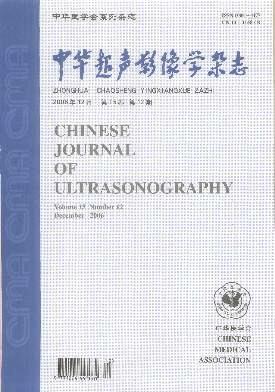Vector flow mapping analysis of left ventricular wall shear stress in normal subjects during diastole
Q4 Medicine
引用次数: 0
Abstract
Objective To observe the change of the left ventricular(LV) wall shear stress (WSS) using vector flow mapping (VFM) in different segments at each phase of diastolic period among normal subjects. Methods From August 2018 to March 2019, 200 healthy volunteers selected from the Physical Examination Center of the Second Affiliated Hospital of Harbin Medical University were recruited. The WSS values of LV segments at the same and at different phases[isovolumic relaxation period(D1), rapid filling period(D2), slow filling period(D3), atrial contraction period(D4)] in diastole were measured and analyzed. Results ①The relationships of the WSS of LV different segments at the same phase of diastolic period: The WSS values of anterior septum, posterior septum and posterior wall during D1, and the WSS values of posterior septum, posterior wall and inferior wall during D2 showed basal>middle>apical segments, the differences were statistically significant (all P<0.05). ②The changes of the WSS values of LV different segments during diastolic period: During D1-D2-D3-D4 period, the absolute values of WSS in anterior septum, posterior septum, anterior wall, lateral wall and inferior wall showed an increasing-decreasing-increasing trend. During D2-D3-D4 period, the absolute values of WSS in the posterior wall showed a decreasing-increasing trend. During D1-D2-D3-D4 period, the absolute values of WSS in the apical segment of anterior septum, basal and middle segments of posterior septum, basal, middle and apical segments of anterior wall, basal segment of lateral wall, the middle and apical segments of posterior wall, basal and middle segments of inferior wall all showed an increasing-decreasing-increasing trend, the difference was statistically significant (all P<0.05). Conclusions The LV WSS in different segments at the same phase or in the same segment at the different phases in diastole exhibit a regular change and is consistent with the LV hemodynamic changes, which indicates that WSS can quantitatively reflect the hemodynamic changes of the LV in normal subjects. Key words: Echocardiography; Vector flow mapping; Wall shear stress; Hemodynamics; Left ventricular diastolic function正常人舒张期左室壁剪应力矢量血流图分析
目的应用矢量血流成像(VFM)技术观察正常人舒张期各阶段不同节段左室壁剪切应力(WSS)的变化。方法2018年8月~ 2019年3月,选取哈尔滨医科大学附属第二医院体检中心健康志愿者200名。测量并分析舒张期左室各节段同期及不同期[等容舒张期(D1)、快速充盈期(D2)、慢充盈期(D3)、心房收缩期(D4)]的WSS值。结果①左室不同节段在同一舒张期的WSS关系:D1期前间隔、后间隔、后壁WSS值,D2期后间隔、后壁、下壁WSS值均为基底节段、中间节段、顶端节段,差异均有统计学意义(P<0.05)。②舒张期左室不同节段WSS值的变化:D1-D2-D3-D4期,前间隔、后间隔、前壁、外壁、下壁WSS绝对值呈增加-减少-增加的趋势。D2-D3-D4期间,后壁WSS绝对值呈减小-增大趋势。d1 ~ d2 ~ d3 ~ d4期间,前间隔根尖段、后间隔基段和中段、前壁基段、中段和根尖段、外壁基段、后壁中段和根尖段、下壁基段和中段的WSS绝对值均呈增加-减少-增加的趋势,差异均有统计学意义(P<0.05)。结论舒张期不同节段或不同时期同一节段的左室WSS变化规律,与左室血流动力学变化一致,说明WSS可以定量反映正常受试者左室血流动力学变化。关键词:超声心动图;矢量流映射;墙体剪应力;血流动力学;左心室舒张功能
本文章由计算机程序翻译,如有差异,请以英文原文为准。
求助全文
约1分钟内获得全文
求助全文
来源期刊

中华超声影像学杂志
Medicine-Radiology, Nuclear Medicine and Imaging
CiteScore
0.80
自引率
0.00%
发文量
9126
期刊介绍:
 求助内容:
求助内容: 应助结果提醒方式:
应助结果提醒方式:


